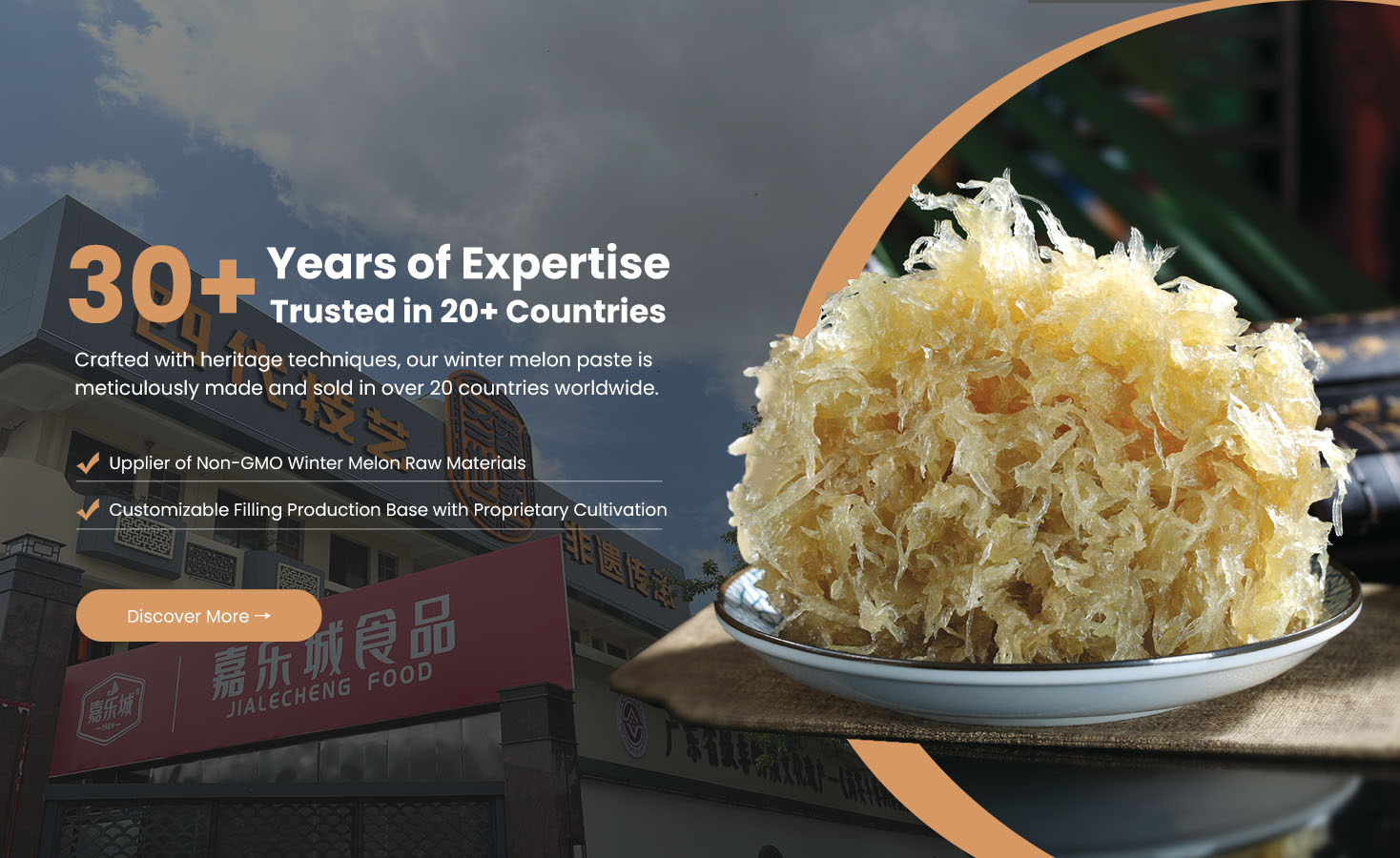How Do Manufacturers Achieve The Translucent Look Of High-Grade Winter Melon Paste?
The signature translucent, golden gloss of premium winter melon paste is one of its defining qualities — signaling high craftsmanship, balanced formulation, and careful control at every stage of production. Unlike matte, cloudy pastes that result from overcooking or poor ingredient ratios, high-grade versions have a clear, jelly-like sheen that reflects both freshness and purity.
Leading producers such as Jialecheng Foods have perfected this appearance through scientific process control, ingredient refinement, and temperature-precise vacuum concentration. Below explains exactly how that clarity is achieved from farm to final filling.
1. Starting with the Right Raw Material
The foundation of translucency begins with high-quality winter melon that has dense white flesh and low fiber content.
Jialecheng’s raw melon standards:
Harvested at full maturity for uniform cell structure.
Moisture: 88–92% for ideal softening during cooking.
Fiber: ≤ 2% (excess fiber scatters light and makes paste opaque).
Flesh color: clean white with no green tint.
| Property | Effect on Appearance |
|---|---|
| Low fiber | Allows light to pass through cooked tissue |
| Fine cell structure | Prevents cloudy texture |
| Freshness | Maintains natural translucence when sugar-infused |
In short, clarity begins at the cellular level — only soft, low-fiber melons can yield a luminous final product.
2. Controlled Sugar Infusion and Osmotic Balance
Translucency develops as sugar replaces water within the melon’s tissues during cooking. This process is known as osmotic infusion.
The melon cubes absorb sugar syrup gradually, turning semi-transparent.
The correct sugar-to-melon ratio is 1 : 0.5 (by weight).
Maltose or glucose syrup is added to stabilize the sugar crystals and enhance light reflectivity.
| Ingredient | Role in Gloss Formation |
|---|---|
| White sugar | Dehydrates cells and creates clear syrup network |
| Maltose/glucose | Prevents crystallization, adds elasticity |
| Vegetable oil | Improves surface reflection and smoothness |
If too much water remains, the paste turns milky and dull; if overheated, it darkens to amber-brown. Hence, precision timing in this step is critical.
3. Temperature Control During Cooking
Color and clarity are highly sensitive to heat. Industrial producers use steam-jacketed vacuum cookers with digital temperature sensors.
Typical stages:
Softening (95–100 °C) — melon begins to release moisture.
Infusion (100–105 °C) — sugar penetrates cells and syrup thickens.
Concentration (105–110 °C) — mixture reaches target viscosity.
Key principle: Maintain uniform heating while avoiding surface caramelization.
Caramelized sugar causes browning and reduces translucence.
| Temperature Range | Result |
|---|---|
| < 95 °C | Paste remains watery, opaque |
| 95–105 °C | Melon turns semi-transparent |
| > 110 °C | Sugar burns → dark, cloudy color |
By keeping temperature stable within ±2 °C, Jialecheng ensures consistent light-amber translucency instead of overcooked opacity.
4. Vacuum Concentration — The Heart of Transparency
The vacuum concentration stage is the most critical for achieving the clear, glossy finish.
Under vacuum (≈ –0.09 MPa), water evaporates at 70–80 °C rather than at boiling point.
This low-temperature dehydration preserves:
Color integrity (no caramel browning)
Sugar uniformity (prevents crystal scattering)
Moisture precision (final 18–22%)
| Parameter | Target | Function |
|---|---|---|
| Pressure | –0.09 MPa | Lowers boiling point |
| Temperature | 70–80 °C | Prevents sugar decomposition |
| Brix value | 68–72° | Achieves light transmission balance |
When complete, the paste appears translucent amber — similar to honey or clear marmalade — instead of cloudy.
5. Homogenization for Smooth Light Reflection
After cooking, the paste is passed through a colloid mill or fine homogenizer to break down any remaining fiber or air pockets that scatter light.
Particle size reduced to < 50 μm.
Deaeration under vacuum removes trapped bubbles.
Small amount of oil (3–5%) is blended in for even sheen.
This step gives the paste a mirror-smooth surface that reflects light evenly — a hallmark of premium Winter Melon Filling.
| Issue | Solution | Result |
|---|---|---|
| Air bubbles | Vacuum deaeration | Clear, glassy surface |
| Coarse fiber | Colloid milling | Uniform translucence |
| Uneven moisture | Continuous mixing | Consistent gloss throughout |
6. Moisture and Sugar Ratio Precision
The ratio between water content and sugar concentration directly affects optical transparency:
| Ratio | Appearance | Texture |
|---|---|---|
| 25% moisture, 60° Brix | Cloudy, soft | Too wet |
| 18–22% moisture, 68–72° Brix | Translucent, glossy | Ideal |
| 15% moisture, > 75° Brix | Hard, brittle | Over-concentrated |
Maintaining this balance ensures the final paste allows partial light penetration, producing a clear amber look without becoming glass-hard.
7. Cooling and Crystal Control
The paste is cooled gradually in a closed cooling tunnel to below 40 °C before packaging.
Rapid cooling can cause sugar crystal formation, which makes the surface appear dull or grainy.
Controlled cooling allows sugars and water to remain in a stable amorphous state, preserving the natural shine.
| Step | Method | Purpose |
|---|---|---|
| Initial cooling | Jacketed cooler | Prevent crystallization |
| Final cooling | Air-cooled conveyor | Stabilize structure |
| Deaeration | Vacuum chamber | Remove tiny air pockets |
8. Vacuum Packaging and Surface Preservation
Finally, the paste is packed warm (35–40 °C) into vacuum-sealed bags.
This prevents oxidation, moisture gain, or surface dullness during storage.
High-grade packaging keeps the paste’s glassy amber tone intact for up to 12 months.
| Packaging Control | Benefit |
|---|---|
| Low oxygen | Prevents oxidation |
| Consistent temperature | Maintains gloss |
| Metal detection | Ensures purity and clarity |
9. Quality Inspection for Translucence
Every production batch at Jialecheng undergoes optical and sensory testing:
| Test | Equipment | Target |
|---|---|---|
| Color value (L* a* b*) | Digital colorimeter | Lightness L = 60–70 |
| Transparency test | Light-transmission meter | ≥ 70% transmittance |
| Texture analysis | Rheometer | Smooth, cohesive elasticity |
| Visual inspection | Trained QC team | No haze or visible fiber |
These metrics ensure uniform appearance across all export batches.
10. Summary: Key Factors Behind the Translucent Look
| Factor | Description | Contribution |
|---|---|---|
| Raw melon quality | Low fiber, white flesh | Clear base material |
| Sugar-water balance | 68–72° Brix, 18–22% moisture | Semi-transparent density |
| Controlled heating | ≤ 110 °C | Prevents caramel browning |
| Vacuum concentration | Gentle dehydration | Maintains color and clarity |
| Homogenization | Removes fibers and air | Even light reflection |
| Gradual cooling | Prevents crystallization | Preserves shine |
| Vacuum packaging | Stops oxidation | Long-term gloss retention |
11. Conclusion
The translucent look of high-grade winter melon paste is not a coincidence — it is the result of meticulous control of chemistry, heat, and light behavior. By carefully balancing moisture, sugar concentration, temperature, and fiber reduction, manufacturers like Jialecheng Foods achieve the prized clear, golden luster that defines top-quality fillings.
This optical purity is more than aesthetic — it reflects a stable, smooth, and bake-ready paste that meets the expectations of professional bakeries and international markets alike.




